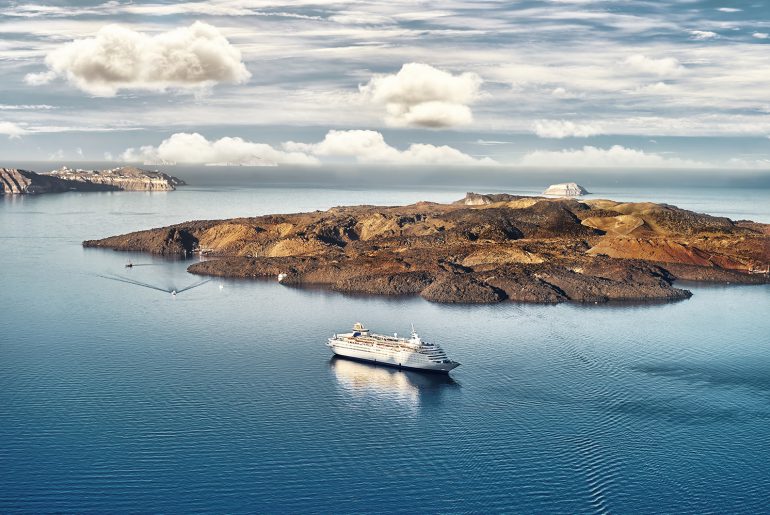The birth of Santorini as you see it today reminds a lot of the legend of the mythical phoenix, the bird that comes back to life rising from its ashes after dying consumed by flames.
Santorini is a story of new life rising from its ashes too. The phoenix of the Greek islands has changed its shape numerous times throughout history, always because of volcanic activity in the Aegean Sea. The Minoan eruption – although scientists cannot pinpoint the date accurately – was the largest in history. It changed the geomorphology of the island and buried all settlements under ash and pumice, putting an end to the Minoan civilization.
After the Minoan eruption (1627 – 1600 BCE), Santorini remained deserted for many years. The outburst was so violent that it ejected 60km³ of ash, rocks, and pumice into the air. Its impact was global. It was followed by two weeks of darkness (night) and two-year long winter and it left the soil on Santorini bare, destroying all flora and fauna, and covering the entire island in a thick layer of ash – according to experts, 60 m high.
It’s a wonder that life flourished again on Santorini after this cataclysm. The myths that tell of the birth of Santorini relate of miracles too. In Apollonius of Rhodes’s Argonautica, we learn of Jason and the Argonauts landing on Anaphe. Here, Euphemus dreamt of making love to a nymph, daughter of Triton, messenger god of the sea. In the dream, the nymph told him she got pregnant and she needed a place to hide from the fury of her father, who would have undoubtedly reacted fiercely to the news. She advised Euphemus to throw a clod of earth from Anaphe into the sea to make her a safe hideout. When Euphemus woke, he followed up on his dream and threw the clod of earth into the waves. Just as the nymph predicted, an island emerged, and he named it Strogyli for its circular shape.
Another myth associates Santorini with the legendary Atlantis. According to some, Santorini may have been the inspiration for Plato’s prosperous and peaceful Atlantis – yet its location was never confirmed. Researchers went as far as the marshlands of Spain to find Atlantis. Besides Plato’s description of Atlantis, there are no other documents to attest its existence. In Plato’s Critias dialogue we learn that:
“Now, on the island of Atlantis there was a great and wonderful empire, which had rule over the whole island and several others, as well as over parts of the continent; and, besides these, they subjected the parts of Libya within the Columns of Heracles as far as Egypt, and of Europe as far as Tyrrhenia. […] But afterward there occurred violent earthquakes and floods, and in a single day and night of rain all your warlike men in a body sunk into the earth, and the island of Atlantis in like manner disappeared, and was sunk beneath the sea.”
No matter how many similarities one finds between Plato’s Atlantis and Santorini, there’s no certitude that the two are the same. Moreover, archeological digs at Akrotiri on Santorini did not unearth the remains of the “warlike men” described by the Greek philosopher.
Whether or not Santorini was the location of Atlantis is less relevant than the miraculous rebirth of the island from volcanic ash after the Minoan eruption. Today, the island flourishes again and counts as the most visited of the Greek islands. Its iconic beauty is a symbol for Greece all over the world and its fiery sunsets inspire all kinds of legends still.
That Santorini is born of fire, there’s no doubt, and the volcano is still active. Its threat is real, but eruptions such as the Minoan one are likely to occur every 15,000-20,000 years according to scientists. The last volcanic eruption on Santorini was 1950 and it lasted 22 days.
Today, volcanic activity on Nea Kameni is monitored by the Institute for the Study and Monitoring of the Santorini Volcano (ISMOSAV) and life goes on safely on the island. Civilization continues to flourish, tourists come and go, and no one worries about another cataclysm.
“If there was another eruption from Santorini/Thera in the near future, the most likely event would be another small, dome-building eruption around Nea Kameni inside the Minoan caldera,” reports Erik Klemetti in an editorial for Discover Magazine. “Most of these eruptions have been VEI 2 eruptions that had phreatic explosions and the extrusion of lava domes/flows. It is very unlikely that we’d seen around Minoan-scale eruption, although Santorini/Thera has seen a number of caldera-forming eruptions (at 180,000, 21,000 and 3,600 years before present).”
With ISMOSAV and the Hellenic Seismic Network constantly monitoring the island, residents and visitors alike can enjoy Santorini worry-free.

